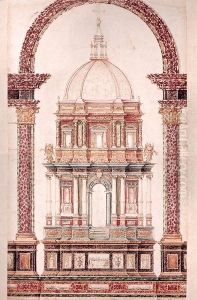Matteo Nigetti Paintings
Matteo Nigetti was an Italian architect and sculptor, born in 1560 in Florence, Italy. Not much is known about his early life and training, but he emerged as a notable artist in the late 16th and early 17th centuries. He was active during a period known as the late Renaissance or Mannerist period, transitioning into the early Baroque. His work is characterized by the ornate style and dramatic expression typical of the Mannerist aesthetic, which often involved exaggerated poses and proportions as well as complex compositions.
Nigetti worked under the patronage of the Medici family, the powerful dynasty that ruled Florence and played a significant role in the promotion of the arts during the Renaissance. One of his most famous works is the Chapel of the Princes in San Lorenzo, Florence, for which he is credited with the design of the ornate interior. The chapel is a mausoleum that houses the tombs of the Medici family and is known for its sumptuous decoration and use of precious materials.
In addition to his architectural work, Nigetti also contributed to sculpture. He collaborated with other artists of his time, which was common practice in the workshops of the Renaissance. His style, while reflective of the tendencies of his time, also showed an adherence to classical harmony and balance, bridging the gap between the high Renaissance and the more expressive Mannerist movement.
Matteo Nigetti passed away in 1626. Although not as widely recognized as some of his contemporaries, Nigetti's contributions to the architecture and sculpture of his time remain a testament to the transitional period in which he worked, and his works are still studied for their stylistic significance and historical value in the context of Italian Renaissance art.
